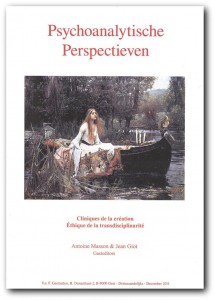Vol 29 (3/4) 2011
Child Psychosis and Therapeutic Mediation – Anne Brun
Borderline Transitions: Bodily, Psychic and Relational Rhythms in Trans(ce)-Analysis – Michel Galasse
The Clinic of Shame and Transmission: The Act of Writing as Support of Transference – Véronique Bourboulon
The Physician and the Victims of Torture – Agnès Afnaïm
Sign Languages, Oral Expression and Writing. On the Writing of a Sign Language – French Bilingual Book – Laurence Meurant
Finding one’s Tongue – Yvette Thoua
The Passage to the Verb – Marc Belderbos
The Logical Times of Sublimation and Architecture – Viviana M. Saint-Cyr
Painting and Psychoanalysis supporting the Translation of Poetry – Rose-Marie François
The Taste of the Subject in Mondovino: An Ethics of Framing – Olivier Beuvelet
“I don’t stop; I start again.” The position of the analyst in ‘long term care’
From a lacanian orientation, the relation between 'treatment', 'coaching' and 'care' is questioned in case of what one calls 'long term care'. This question is approached from the perspective of a case study. A young man accuses himself constantly of not adapting...
Vampires, Viruses and Verbalisation: Bram Stoker’s Dracula as a genealogical window into fin-de-siècle science
This paper analyses Bram Stoker’s classic Dracula as a literary document which reflects important scientific and technological developments of the fin-the-siècle era, ranging from blood transfusion and virology via psychotherapy and psychoanalysis up to brain research...
Psychoanalysis: a symptomatic problem
In this article the author explores why psychoanalysts are often seen as troublesome people and why they give so much critique. Foucault stated that in modernity the epistèmè changed: ‘man’ came in the thinking frame and human sciences were born. In his opinion...
The Violence of Right: Rereading ‘Why War?’
In this contribution, the often neglected correspondence ‘Why War?’ (Freud, 1933b) is presented as the locus classicus of Freud’s account of ‘Right and Violence’. In the discussion with Freud, Einstein’s position appears in the light of Kant’s Toward Perpetual Peace....
The Taste of the Subject in Mondovino: An Ethics of Framing
"First of all, on the surface I am going to paint, I draw a rectangle of whatever size I want...". From the origin of modern representation dated to 1435 with Alberti's finestra aperta and which sets the sovereign choice of the painter (as well as his taste) as the...
Painting and Psychoanalysis supporting the Translation of Poetry
The English poet Sir Alfred Tennyson (1809-1892) claimed that something of him was to be found in The Lady of Shalott (first version in 1832, second version in 1842). A close reading of some stanzas shows that several translations miss the key-moment of the poem. If...
The Logical Times of Sublimation and Architecture
This article begins by analyzing Lacan's famous formula from the seminar The ethics of psychoanalysis: sublimation "elevates an object to the dignity of the Thing" (Lacan, 1986 [1959-1960]: 133). Our hypothesis is that this operation has a logical sequence. We will...
The Passage to the Verb
This paper discusses architecture and the place (lieu) not as conceptualised by philosophy, by physics or even popularly as a milieu, an environmental continuum but rather as the effect of an operation: An operation of division, of a cut, as psychoanalyst; an...
Finding one’s Tongue
For children who are deaf – that is to say, who cannot hear sound – from the outset communication involves what they can see, touch, feel, sense, and transmit to others through gestural signs (body language). This happens intuitively , and this process is as...
Sign Languages, Oral Expression and Writing. On the Writing of a Sign Language – French Bilingual Book
Sign languages, and among them French Belgian Sign Language (LSFB), illustrate that the embodiment of language can take different forms. Sign languages demonstrate that sound does not define linguistic ability and that a phoneme is not a sound. The gaze that the...
